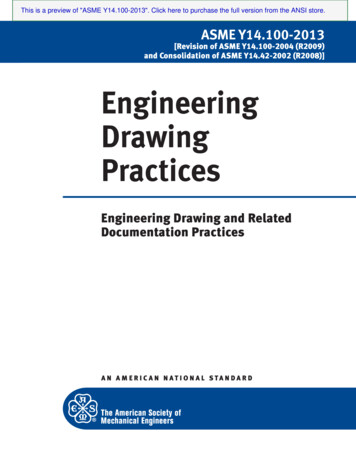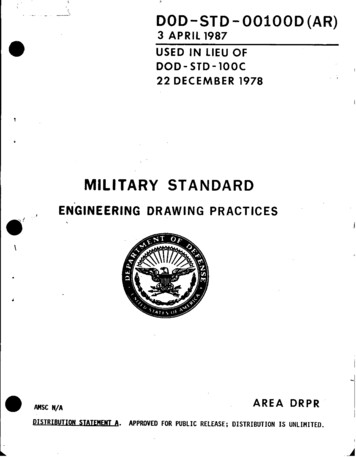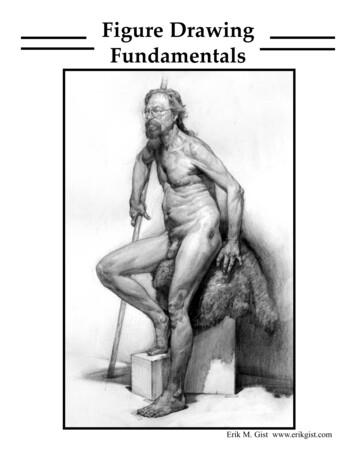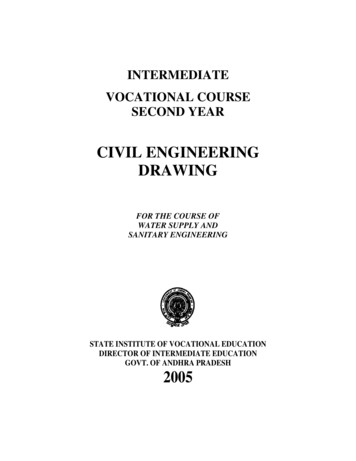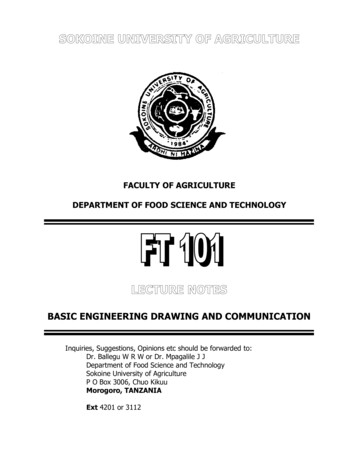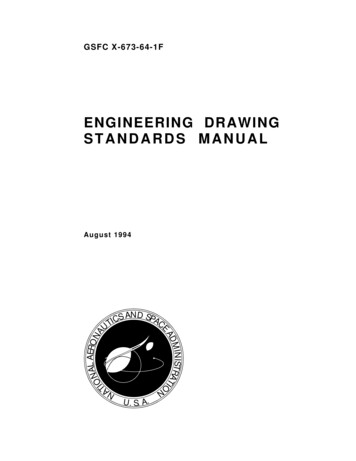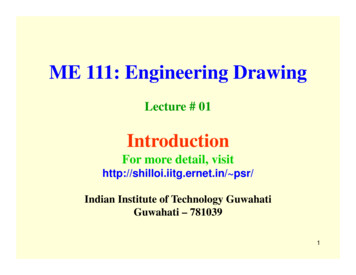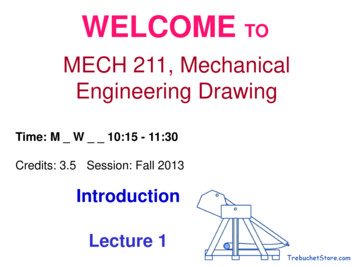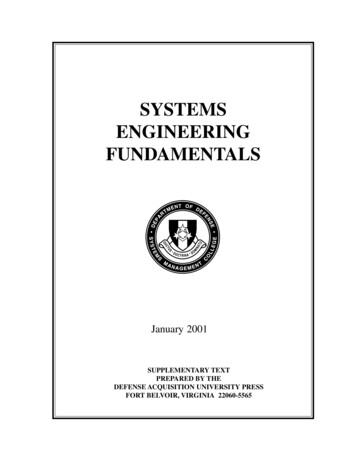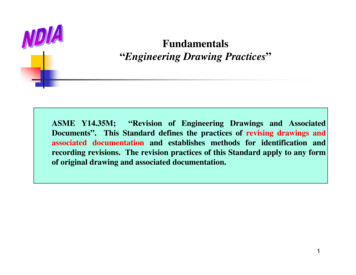
Transcription
Fundamentals“Engineering Drawing Practices”ASME Y14.35M;“Revision of Engineering Drawings and AssociatedDocuments”. This Standard defines the practices of revising drawings andassociated documentation and establishes methods for identification andrecording revisions. The revision practices of this Standard apply to any formof original drawing and associated documentation.1
Fundamentals“Engineering Drawing Practices”Drawing PracticesDrawing practices associated with drawing changes shall beconsistent with those already used on the drawing to be revisedunless the latest of applicable standards can be incorporatedwithout conflict. Any change to a drawing after release, includinga change to “Rights in Data”, shall be recorded in the RevisionHistory Block.1.Revision MethodsChanges may be made by adding, deleting, or crossing out theinformation or by re-drawing the drawing.2
Fundamentals“Engineering Drawing Practices”Drawing Practices2.Re-Drawn DrawingsDepending on the circumstances, drawing may be redrawn eitherwith or without change.1)With Change (Revision letter is advanced)When a revision warrants re-drawing of the drawing, the revisionletter next in sequence shall be entered in the REV column of theRevision History Block of the new drawing.3
Fundamentals“Engineering Drawing Practices”Drawing Practices2.Re-Drawn DrawingsDepending on the circumstances, drawing may be redrawn eitherwith or without change.2)Without Change (Advance of revision letter is not required)When a drawing, or a sheet of a drawing, is to be replacedbecause of loss, destruction, or degradation due to age it may bere-drawn without change. The replacement shall duplicate therequirements of the old original which is being replaced.4
Fundamentals“Engineering Drawing Practices”Drawing Practices3.Superseding a Drawing with that of a Different Numbera)Superseding (New) Drawing.When a drawing is superseded by a drawing with a different number,the notation “REPLACES WITH CHANGE DRAWING (Entersuperseded drawing number) REV (Enter superseded revision letter orif no revision enter a – [dash]) shall be entered in the DESCRIPTIONcolumns of the superseding drawing.No entry is required in the REV letter, DATE or APPROVED Column.New Title Block Approval entries apply.5
Fundamentals“Engineering Drawing Practices”6
Fundamentals“Engineering Drawing Practices”Drawing Practices3.Superseding a Drawing with that of a Different Numberb)Superseding (Old) Drawing.When the superseded drawing will be retained, the notationREPLACED WITH CHANGE BY DRAWING (Enter the supersedingdrawing number) REV (Enter the revision letter of the supersedingdrawing or if no revision, enter a – [dash]) shall be entered in theDESCRIPTION column of the superseded drawing.7
Fundamentals“Engineering Drawing Practices”Drawing Practices4.Revisions of Digital DataRevisions of digital data files and copies of digital data files shall not beconsidered re-draws except when the document is converted from amanually maintained to a digitally maintained document.8
Fundamentals“Engineering Drawing Practices”Drawing Practices4.Identifying Revisions on Drawings Revision Letters. Upper case letters shall be used in sequence beginning with Aand omitting letters “I”, “O”, “Q”, “S”, “X”, and “Z”. When the single letters have been exhausted, the revisionsfollowing “Y” shall be “AA”, “AB” through “AY”. Should “AA” to “AY” be exhausted the next sequence shall be“BA”, “BB” through “BY”. Revision letters shall not exceed two characters. Initial issue of a drawing does not constitute need for a revisionletter and may be indicated by the use of a – [dash].9
Fundamentals“Engineering Drawing Practices”Drawing Practices4.Identifying Revisions on Drawings Revision Locations. When incorporating a change or replacing thedrawing with change, a revision location shall be identified by oneor more of the following methods; Revision symbol in the field of the drawing; Description in the Revision History Block; Zone locations in the ZONE Column of the Revision History Block; Revision authorization document identified in the DESCRIPTION orother dedicated column of the Revision History Block.10
Fundamentals“Engineering Drawing Practices”Drawing Practices4.Identifying Revisions on Drawings Multiple Changes.All changes authorized by a single revision authorizations document shallbe incorporated into the document at the same time. All changes to adrawing incorporated at one time shall be identified by the same revisionletter if the revision letter is assigned at the time the changes areincorporated.Sequence Number Use. When a revision involves two or more individualchanges on a drawing, each change may be identified by a sequencenumber enclosed in parentheses preceding the description of the change.11
Fundamentals“Engineering Drawing Practices”Drawing Practices4.Recording RevisionsChanges to drawings shall be recorded in the Revision History Block. TheRevision History Block format shall be in accordance with ASME Y14.1.5.Revision ControlRevisions may be by; Drawing Level Method Sheet Level Method; or by All Sheets Same Revision Level Method.12
Fundamentals“Engineering Drawing Practices”Drawing Practices6. Associated Document RevisionsAssociated documents (DL, IDL, AL, PL, WL, IL) are revised in thesame manner as for any other revision to a drawing. Associateddocuments may be revised as a separate document. See ASMEY13.34 for associated list preparation requirements.Associated documents need not be revised for the sole purposeof maintaining a common revision level.13
Fundamentals“Engineering Drawing Practices”ASME Y14.100; “Engineering Drawing Practices”. This Standard establishesthe essential requirements and reference documents applicable to thepreparation and revision of engineering drawings and associated lists. It isessential that this Standard be used in close conjunction with ASME Y14.24,ASME Y14.34M, and ASME Y14.35M.14
Fundamentals“Engineering Drawing Practices”Types and Application of Engineering Drawings1.Associated Lists (IAW ASME Y14.34M)2.Revisions of Engineering Drawings and Associated Lists(IAW ASME Y14.35M)3.Size and Format of Engineering Drawing (IAW ASME Y14.1)4.Application DataWhen used, application data with “Next Assembly” and “Used On”columns are required for drawings whose detail part or assembly depictedthereon is for an element of a larger item.15
Fundamentals“Engineering Drawing Practices”Types and Application of Engineering Drawings5.Preparation of Duplicate OriginalDuplicate originals shall not be prepared for the purpose ofmaintaining duplicate records. Their application is limited toreplacing lost original drawings.6.Line Conventions and Lettering (IAW ASME Y14.2M)7.Single, Multiple, and Sectional View Drawings (IAW ASMEY14.3M)8.Isometric and Pictorial Views (IAW ASME Y14.4M)16
Fundamentals“Engineering Drawing Practices”Types and Application of Engineering Drawings9.Projection Systems (IAW ASME Y14.3M)10. Dimensioning and Tolerancing (IAW ASME Y14.5M)11. Surface Texture (IAW ASME B46.1 and ASME Y14.36M)12. Screw Thread Representation (IAW ANSI Y14.6 and Y14.6aM)13. Gears (IAW ANSI Y14.7.1 and Y14.7.2)14. Mechanical Springs (IAW ANSI Y14.13M)15. Optical Elements and Optical Systems (ASME/ANSI Y14.18M17
Fundamentals“Engineering Drawing Practices”Types and Application of Engineering Drawings16. Casting and Forgings (IAW ASME Y14.8M)17. Circuit Diagrams (IAW ANSI/IEEE 991)18. Digital DataEngineering drawings prepared by other than manual means (such ascomputer generated drawings) shall provide all of the informationrequired by the particular drawing type or level of design disclosure.Variations to accommodate document preparation will be acceptableso long as these variations meet the requirements relative to theinformation contents.18
Fundamentals“Engineering Drawing Practices”Types and Application of Engineering Drawings19. ScaleScale expresses the ratio of the size of the object as drawn to its fullsize. Drawings shall be drawn to a scale that depicts all details of theitem clearly and accurately.Drawings Not to Scale: In the case of diagrams, pictorials, cableassemblies, tabulated and other drawings not prepared to any scale,the word “NONE” shall be entered after “SCALE” in the space providedon the drawing format.19
Fundamentals“Engineering Drawing Practices”Types and Application of Engineering Drawings20. Drawing NotesDrawing notes provide information that clarifies the requirements forthe item delineated. They apply to either a portion of the drawing or tothe entire drawing providing additional treatment, finish, protection, andother considerations.The Notes area of a drawing shall be identified with the heading“NOTES”20
Fundamentals“Engineering Drawing Practices”Types and Application of Engineering Drawings21. Metric PracticesThe measurement system in which the part, item, or any of its features isdesigned shall be used in the documentation for that part, item or feature.22. Drawing TitlesGeneral Rules: The title shall be as brief as possible, describe the item, and distinguishbetween similar items.The title shall consist of a noun or noun phrase (basic name).The noun or noun phrase establishes the basic concept of an item.21
Fundamentals“Engineering Drawing Practices”Types and Application of Engineering Drawings22. Drawing TitlesGeneral Rules (cont’d): The noun or noun phrase shall be used in singular form, exceptfor items such as Tongs, Gloves, Fuses. An ambiguous noun is not used alone;PreferredNot PreferredCIRCUIT CARD ASSEMBLYASSEMBLY, CIRCUIT CARDPRINTED CIRCUIT BOARDBOARD, PRINTED CIRCUIT22
Fundamentals“Engineering Drawing Practices”Types and Application of Engineering Drawings22. Drawing TitlesGeneral Rules (cont’d): When an item is neither container nor material, but its nameinvolves the use of a noun that ordinarily designates a container ormaterial, a noun phrase shall be used, for example;PreferredNot PreferredJUNCTION BOXBOX, JUNCTIONSOLDERING IRONIRON, SOLDERING23
Fundamentals“Engineering Drawing Practices”Types and Application of Engineering Drawings22. Drawing TitlesGeneral Rules (cont’d): Abbreviations should be avoidedThe title shall be consistent with the title of the next assemblyWhen titles are used on continuation sheets, the title shall be the same oneach sheet.Reference to major assemblies or end items shall not be used exceptwhen necessary to differentiate similar items.Nonpart drawings, such as schematic diagrams, shall include the drawingtype as part of the title, for example; “TRANSFORMER ASSY,SCHEMATIC DIAGRAM”24
Fundamentals“Engineering Drawing Practices”Types and Application of Engineering Drawings23. Numbering, Coding, and IdentificationDrawing NumbersDrawing numbers consist of numeric, alpha, or special characters, orcombinations thereof. Spaces are not used between any of the elementsof a drawing number.Although there is no National Consensus limitations on drawing numberlength, many drawing number systems limit themselves to 15 characters(including the base number, and any required prefixes, suffixes, andseparators).25
Fundamentals“Engineering Drawing Practices”Types and Application of Engineering Drawings23. Numbering, Coding, and IdentificationPart or Identifying NumberThe Part or Identifying Number (PIN) is an identification assigned by theoriginal design activity or by the controlling nationally recognizedstandard for the purpose of uniquely identifying a specific item.The PIN does not include the drawing revision identifier, drawing size, oractivity identification.A widely recognized limitation on PIN number length is 32 characters.26
Fundamentals“Engineering Drawing Practices”Types and Application of Engineering Drawings24. Markings on DrawingsMarkings are used in support of, and in addition to, graphics and text toconvey information about the drawing, the list, or items depicted thereon. Symbology Duplicate Original Notation Duplicate Production Master Drawing Notation CAD Generated Drawing Note27
Fundamentals“Engineering Drawing Practices”Symbology28
Fundamentals“Engineering Drawing Practices”DuplicateOriginal29
Fundamentals“Engineering Drawing Practices”DuplicateProduction“Master”30
Fundamentals“Engineering Drawing Practices”CADGeneratedDrawingNote31
Fundamentals“Engineering Drawing Practices”Types and Application of Engineering DrawingsIn General Y14.100 refers to the Y14 series for specific guidance.In addition there are several “Non-Mandatory” Appendix’s within thedocument;Appendix A - Tailoring ChecklistAppendix B – Non-Commercial Drawing PracticesAppendix C – Drawing TitlesAppendix D – Numbering, Coding, and IdentificationAppendix E – Markings on Engineering Drawings32
drawing incorporated at one time shall be identified by the same revision letter if the revision letter is assigned at the time the changes are incorporated. Sequence Number Use. When a revision involves two or more individual changes on a drawing, each change may be identified by a sequence number enclosed in parentheses preceding the description of the change. 12 Fundamentals “Engineering .
